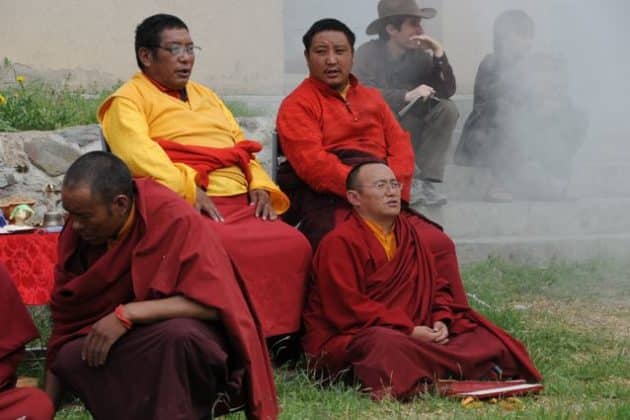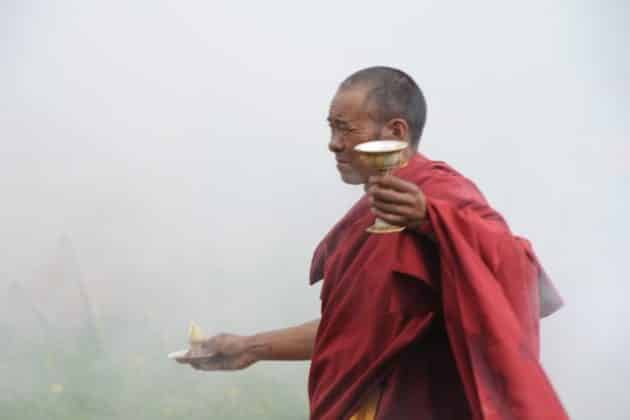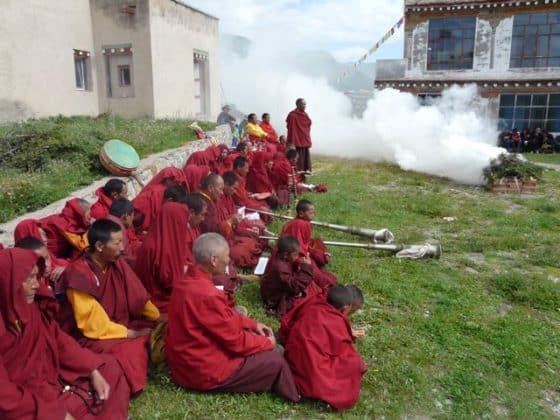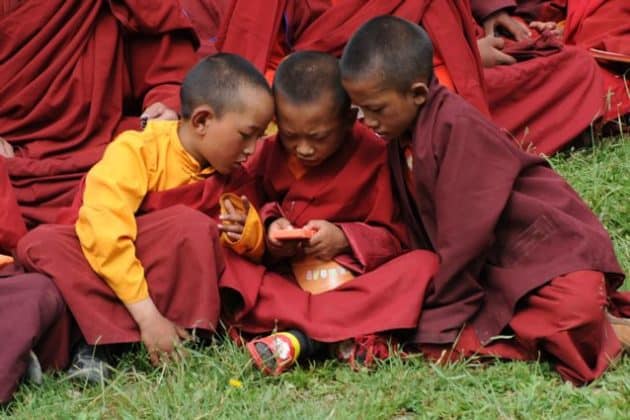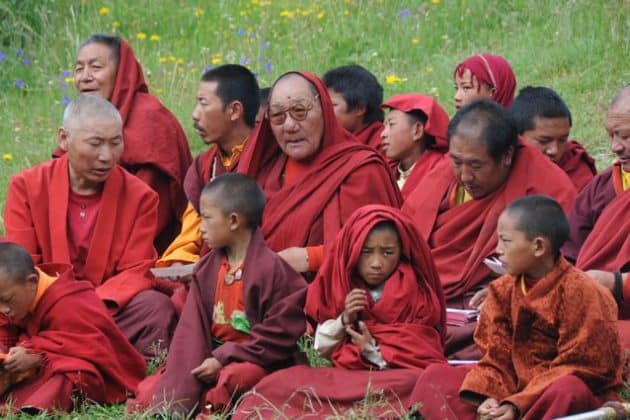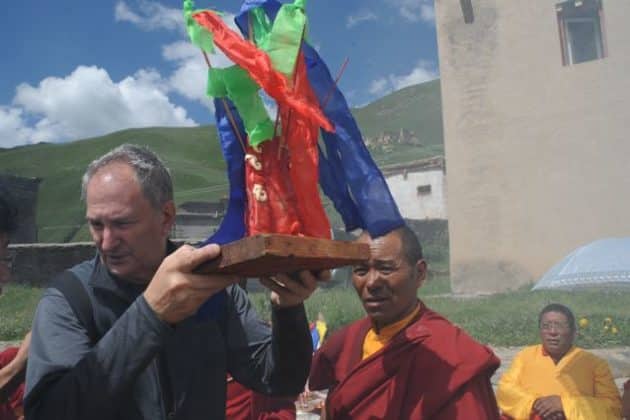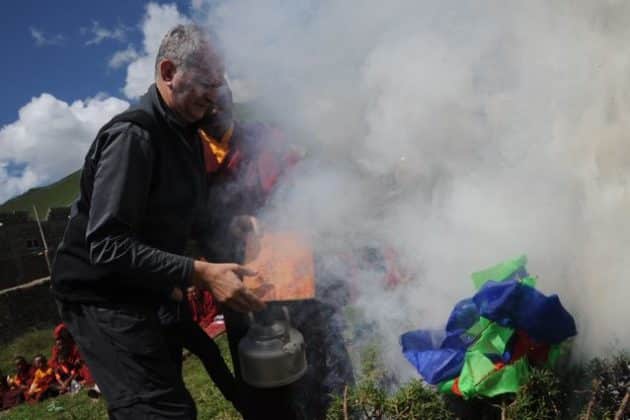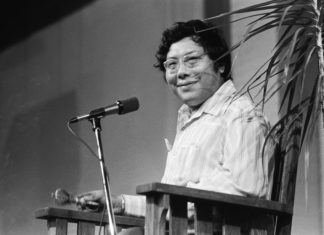Encounter with Damchu Rinpoche
We got a call from Surmang Foundation Regional Director Tsondru Tsering inviting us to his house for lunch I’ve known Tsondru and his family since 1992, when Pema Wangyal, Tibetan Buddhist scholar and translator (now living in Berkeley, California) and I traveled to Surmang and stayed there. Puchu-la, Tsondru’s late father short, pugnacious, and balding with a comb-over was the patriarch of the family was the axis mundi of my next 4 years at Surmang. We were connected through Gozi Along, the head of the religious affairs department and the friend who issued the permit for me to go to Surmang in 1987, FIVE months after the Vidyadhara’s cremation.
During his life, Puchu-la was the go-to man for all our projects at Surmang, having been the construction manager of our clinica job that lasted 3 years. Now the mantle of that work has been passed to his son Tsondru Tsering (eternal diligence).
At that time, in the early 1990s, Tsondru was a quiet son, one of 4, and brother to 4 sisters. In 1996 when I lived in Shanghai, working for Project Hope, Puchu-la paid us a visit, came seeking a medical cure for a benign tumor growing on his brain, a tumor that would take his life a few years later.
In a lot of ways my experience of Kham and Surmang were framed by my connection to Puchu-la and his family. Their big family is from Surmang and still has a strong presence therenow in the form of the children and their children. One such is Phuntsok, our clinic director. His father was Puchu-la’s brother.
I think I stayed at his house for 4 summers running, until Public Security one year told me I didn.t have the right to stay at a Chinese persons house. The visits were usually eat and drink-a-thons, and I vividly remember him walking into a room in his house with 5 bottles of bai jiu white lightning, me totally drunk thinking that my body could not hold any more liquid but wondering what kind of room it came from.
Now 16 years on, the sons and daughters are all grown and I was going with my 11 year-old son Joseph whom they.ve never seen before. We (myself, Joseph, and Jake Hooker, a project manager from 6 years ago and now Pulitzer Prize winning journalist) got in a taxi and headed off to Red Protector Road.
Of course Joseph, tall, handsome, and self-effacing, was the star of the show. Joseph was like a duck in water eating a lunch of boiled mutton, yak jerky and vegetables. Amidst all the small talk was a surprising announcement that Damchu Rinpoche, the Vidyadhara’s younger brother, was not only in town, but was a few houses away. I’ve always felt close to Rinpoche whose warm hands have always held mine, like I was a little child.
Not long after I could see him ambling through the doorway. We all stood up and he sat down on the couch near where I was sitting, and immediately held my hand.
The conversation drifted to his monastery, Surmang Jheregon [aka: Kyere Gompa], and to Trungpa Rinpoche. I asked him about the time in 1958, just prior to the Vidyadhara’s escape, when he found the terma at the White Face Mountain, which sits directly above Jheregon.
Due to my fractured Khampa-ke, it took a while to communicate what I meant by terma, the teachings buried by Guru Rinpoche 1300 years ago, to be discovered at an appropriate time in the dark age.
He said, I was there! There were about 4 of us, including one Lama who recently passed away. I was curious about the contents of the discovery. He said it occurred in two phases. The first day, in the company of a small group, he pulled out the hair of Yeshe Tsogyal and a phurba of meteoric iron. He asked me if I knew about the phurba, and I said “Yes! I saw it … on the neck of Akong Rinpoche.” He asked me how it got on his neck and I told him that it was a story much too long to repeat here.
Damchu Rinpoche said, “After the first day the Vidyadhara announced he would get more terma and went back to the mountain.” This time there were many hundreds of people to witness this electric event. So Trungpa Rinpoche reached into the rock and pulled out the scrolls containing several teachings written in the Dakini Script, which is neither Tibetan nor Sanskrit. He immediately translated them. These are among the texts we have today, transmitted by Karseng Rinpoche, Damchu Rinpoche’s and Trungpa Rinpoche’s nephew.
I asked him about what Trungpa Rinpoche did next, because I heard the story, Don’t Go to Dutsi-til. He said basically there was a drupchen at Dutsi-til that Trungpa Rinpoche had to leave, and his attendants were getting very nervous because he was delaying his return. Damchu Rinpoche said that the reason Trungpa Rinpoche delayed his return, was because he did a kind of mo, or pracena, in which the Vidyadhara could basically tell the future by looking into a small mirror.
The pracena told him not to return to Dutsi-til. He thought the Chinese army would arrest him if he returned. So he sent a monk to secretly assess the situation. When he returned, the monk told the Vidyadhara that Surmang Dutsi-til was basically destroyed, and the Chinese army was searching for the young Trungpa Rinpoche.
I asked Rinpoche about another version of that story that I read on the Translation Committee’s website. In this version, after great pleading, the Vidyadhara basically gives in to the imprecations of his handlers and returns to Dutsi-til. However, at the big pass outside of Jheregon, the 4 armed Mahakala appaears to Trungpa Rinpoche and says, “Don’t go to Dutsi-til,” at which point Rinpoche turns around and begins the journey that ends in his arrival in India.
Damchu Rinpoche said, “Yes, I’ve heard that. Which one do you believe?” Being politically safe, I said, “Both!”
Photos by Lee Weingrad




